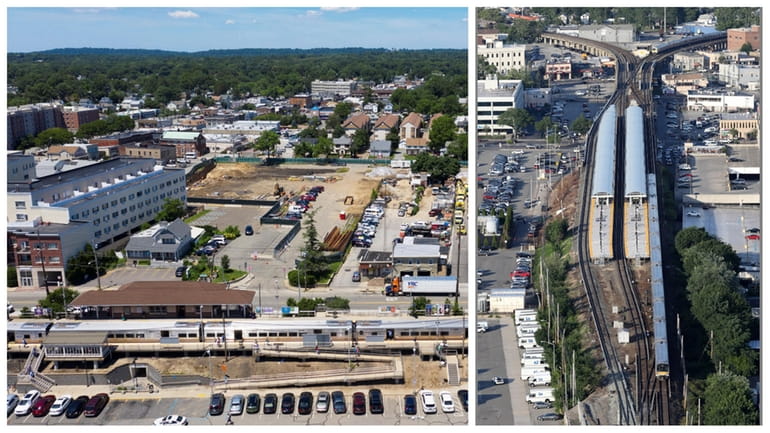MTA land at LIRR stations can be used to build more housing

Aerial views of the land near the Westbury LIRR station, left, bounded by Post Avenue on the west and School Street on the east, and the Hicksville LIRR station. Credit: Yeong-Ung Yang, Newsday / John Keating
The two most contentious issues in the debate over Gov. Kathy Hochul's budget have been the creation of more housing and the finances of the Metropolitan Transportation Authority.
But there has not been enough discussion about how to meld them together.
One of the best ways to build more housing on Long Island is to make better use of plots of land the MTA owns or controls — particularly parking lots — around Long Island Rail Road stations. Each stretch of asphalt is a wide-open swath of opportunity. But too often, towns, villages and hamlets haven't taken advantage of this potential right in front of them.
Using property adjacent to the stations for housing isn't a new concept. It's rarely simple to do. Sometimes, the land isn't owned by the MTA, but by the municipalities. Even when it is MTA land, building on it won't solve the authority's financial problems, which eclipse anything the MTA could reap from selling, swapping or leasing the real estate.
But recent attention on the need for more housing across the region provides the impetus to renew the conversation on how the state agency can work with local governments to jump-start development at available sites.
LOCAL SUCCESS STORIES
Long Island already has some success stories upon which to build, such as Mineola, Ronkonkoma, and Westbury.
In Westbury, the MTA partnered with Mayor Peter Cavallaro to build a parking garage so the authority could create a mixed-use development on what had been a commuter lot. The village rezoned the area and the MTA solicited proposals from developers, ultimately choosing Mill Creek Residential Trust, which could put up more than 200 units and provide more than $600,000 in annual lease payments to the MTA.
In other places, the MTA has used land swaps to expand development opportunities. In Wyandanch, the MTA built a parking garage on land owned by the Town of Babylon, and the town used MTA property for mixed-use development as part of the Wyandanch Rising complex.
Replicating these examples hasn't been easy. The Town of Oyster Bay and the MTA spent years arguing over efforts to redevelop downtown Hicksville. Battles were fought over whether the MTA could and would build a parking garage on its land near the station. Then came dust-ups over the maximum height the town would permit for mixed-use development, how to use MTA and town land, and whether land swaps could occur.
The result was delay and stagnation. While Hicksville's downtown revitalization plans finally are moving forward, they're focused on plazas and streetscaping. Some housing is expected to come to Hicksville, but not the number of units that would create a vibrant, walkable downtown community.
In its own analysis, the MTA highlights five stations and their communities as ripe for the kind of "transit-oriented development" opportunities Hochul wants: New Hyde Park, Westbury, Babylon, Ronkonkoma and Port Jefferson. In Westbury and Ronkonkoma, housing construction and other development is already underway.
What sets those spots apart is that the MTA owns some of the street-level parking lots. At many other LIRR stations, parking lots and other open space are either municipally owned or privately controlled. That doesn't rule out transit-oriented development but it does put more of the onus on the town or village.
Of course, using these lots for development means finding ways to replace at least some of that parking. Garages can be expensive, although Hochul's infrastructure funds could help. "Last-mile" rides, shuttles, and other options should also be considered.
REJECT ONE-SIZE-FITS-ALL
The possibilities of using MTA property illustrate why it's important to avoid a one-size-fits-all approach when building housing Islandwide. The state should seize the opportunity at LIRR stations and work with communities to establish "organic" plans, an approach that would encourage village and town leaders to be innovative and collaborative.
State, local and MTA officials should examine success stories like Westbury, Patchogue, and Wyandanch to determine why and how they worked. They should better examine and work more closely with locations where more can be done, like Hicksville or other communities along the Main Line where train service is on the rise, like Floral Park or Merillon Avenue.
MTA officials have been down this path before, and should know what works and what doesn't. After all the progress they have made in improving the LIRR, they should have a bigger role in housing solutions.
It's also worth listening to those who've had some success. Even with the zoning and development strides he's made, Cavallaro, the Westbury mayor, said he doesn't support Hochul's current housing proposal. TOD, he says, should go "where it makes sense." But he also suggests every community take an honest look at how it's handling housing, transit and redevelopment, and consider what's possible. Some municipalities, he said, are just "taking a dog-paddle approach, where they're mostly treading water."
"You're not going to be able to do that forever," Cavallaro said.
MEMBERS OF THE EDITORIAL BOARD are experienced journalists who offer reasoned opinions, based on facts, to encourage informed debate about the issues facing our community.
